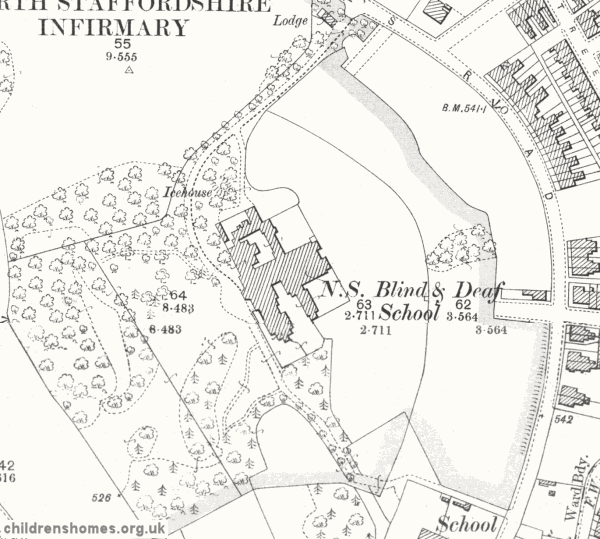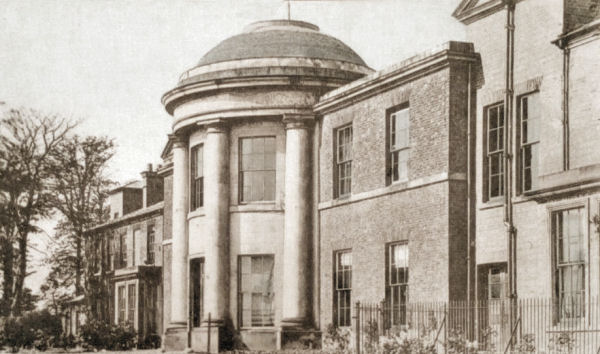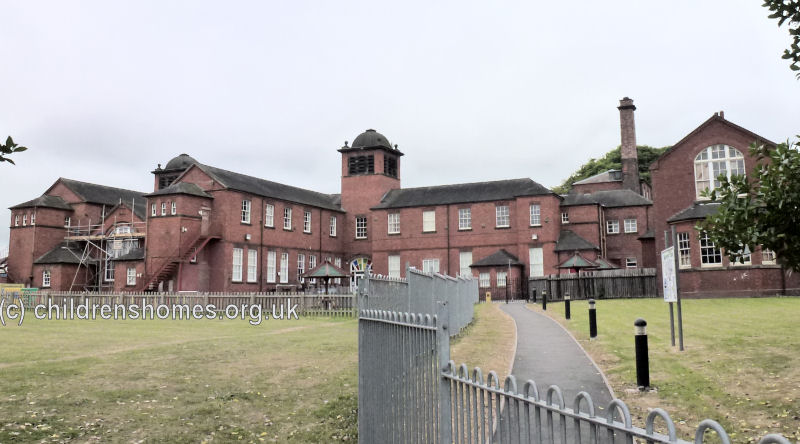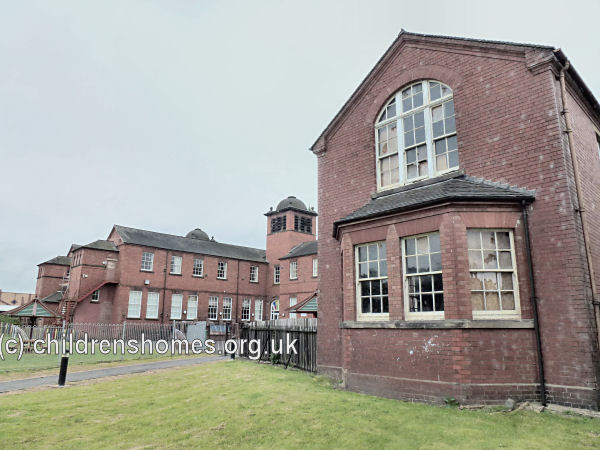North Staffordshire Blind and Deaf School, Stoke-on-Trent, Staffordshire
the Elementary Education (Blind and Deaf Children) Act 1883 gave every school authority the duty of providing efficient and suitable education for all deaf children between the age of 7 and 16, and for all blind children between the age of 5 and 16, except for the children of paupers, for whom Boards of Guardians were responsible, and imbeciles. Local school authorities could meet this obligation in three ways: a) by sending such children to existing charitable institutions; by establishing day classes within their catchment area; or by establishing boarding schools managed by one or more school authorities.
In May 1894, following a meeting convened by Mr Godfrey Wedgwood, representatives of the Stoke, Hanley, Longton, Wolstanton and Norton School Boards agreed to form the North Staffordshire Joint School Authority, which subsequently decided to take the latter route. The Authority subsequently purchased just under six acres of the Mount Estate, including its large house, at the west side of what is now Greatbach Avenue, Penkhull, near Stoke-on-Trent. Following the necessary alterations and additions to the premises, for which Messrs Scrivener and Sons were the architects, the North Staffordshire Blind and Deaf School was opened in May 1897. It was the first residential school of its kind to be established under the 1838 Act.
The existing house on the site was used for the school's administrative departments. New buildings were erected at its rear — southwards for the blind and eastwards for the deaf children, the majority of its 139 places allocated to the latter. The first headmaster was Arthur J. Story.
The School site is shown on the 1898 map below.

North Staffordshire Blind and Deaf School site, Stoke-on-Trent, c.1898.

North Staffordshire Blind and Deaf School, from the south, c.1905. © Peter Higginbotham

Former North Staffordshire Blind and Deaf School, from the north-east, 2013. © Peter Higginbotham

Former North Staffordshire Blind and Deaf School, from the north, 2013. © Peter Higginbotham
Following the 1902 Education Act, which abolished School Boards, oversight of the School passed to the newly constituted North Staffordshire Blind and Deaf Authority.
In July 1913, an complete open-air school was officially opened at the site which allowed the education of the children to take place outdoors during the summer months. A boys' camp was also erected to enable the boys to sleep in the open air. A local newspaper reported on the proceedings:
There are 143 children in the institution — ll2 deaf and 31 blind. For some years, it has been the policy of Mr. Story, the devoted head-master, to make as much use as possible of the extensive grounds not only for out-door exercises and games but for open air leaching. His belief has been that teaching in the open air is preferable because the fresh air is both physically and mentally invigorating, and he has demonstrated that any fears of distraction are groundless. But there were drawbacks in the way of liability to be driven in-doors by rain, or wind, or even hot sun. Mr. Story conceived the idea of equipping an open-air school by erecting classrooms with open sides, and obtaining the sanction of the committee, he and his staff and the boys last year built seven such classrooms, which enabled the number of classes to conducted in the open air from April November. The experience was entirely satisfactory. The physique of the children improved materially, and the chief result was the improved health of the children during the winter. The experiment having proved so obviously advantageous, the committee sanctioned the erection of seven more classrooms, and these have been built this year, making 14 in all, which afford sufficient accommodation for the whole school. The classrooms are substantial wooden structures, with brick foots. The back is built up of wood, but the other three sides are open from about three feet above the ground to the roof, with canvas blinds which can be drawn to keep out wet if necessary. They are dotted about under the trees, and the surroundings have been nicely laid out as garden and shrubberies. The open-air school is a remarkable testimony to the forethought and initiative of the head-master, and to the practical skill and thoroughness of the amateur builders. Mr. Story and his colleagues had no pattern to copy; the school is the outcome of their own original thought and design. It is splendidly successful, and, withal, remarkably cheap, for the cost of the whole is merely the cost of the materials used. The summer camp stands in a small clearing a short distance from the school, and is equally well designed and built. For some years an effort in the direction of a summer camp had been made with bell-tents and movable equipment. But the continuous wet weather last summer had so disastrous an effect upon this effort that it was decided to go in for a permanent camp. This was erected in the same way as the classrooms. The materials were purchased and substantial wooden erections were built, including a dining-room, kitchen, bathing-place, sleeping pavilion, &c. The latter has some 14 beds, upon a raised wooden floor, with substantial roof, and open sides, hung with canvas curtains which can be drawn for protection against rain or other rough weather. The camp can run during the summer months, and the elder boys sleep there in batches of ten or a dozen for a week a time. The blind boys participate in this camp life, the healthful effects of which have already been strikingly demonstrated. The cost of the materials used in the camp and the open-air school was £3OO. Towards this, £l5O has been contributed, and £l5O remained to be raised by subscription, as the cost could not be charged to the rates. One object of the gathering under notice was to arouse interest in the work and invite contributions towards the comparatively small sum required.
The visitors inspected the open-air school at work, and were deeply Interested in the process of imparting instruction, both to the deaf and the blind from the very beginning to the closing months of their stay at The Mount. Remarkable indeed are the results achieved, as one realized when invited to speak with a bright and sharp witted girl of 15, shortly to leave on completing her sixteenth year, who had never heard sound of any kind from birth, but who was able to converse quite readily, reading the words spoken from the movements of the lips, and articulating her own answers in a fairly clear voice, without hesitation difficulty, and in a way that made it difficult to comprehend that she possessed no oral faculty whatever. This bright, intelligent, and happy girl was typical of many scores who have entered this institution as helpless little deaf mutes, have spent there a happy childhood, and have gone forth fairly well equipped to bear a useful part in life.
In 1925, Mr N.S Follwell and his wife were appointed as headmaster and matron of the School, positions they were to hold until 1944. Their son, Mr Sidney N. Follwell then took over as headmaster.
In 1949, the school ended the admission of blind children, with the existing blind pupils being transferred to the Birmingham Institution for the Blind.
From the mid-1980s, the school was known as the Mount School for the Deaf. It continued to provide education for deaf children until 2000, when the City Council decided to close it and merge those pupils into mainstream education.
The Mount site is now home to Penkhull Children's Centre.
Records
Note: many repositories impose a closure period of up to 100 years for records identifying individuals. Before travelling a long distance, always check that the records you want to consult will be available.
- Stoke on Trent City Archives, Hanley Library, Bethesda Street, Hanley, Stoke on Trent ST1 3RS. Has records covering the period 1896-2001, uncatalogued at the time of writing.
Bibliography
- Higginbotham, Peter Children's Homes: A History of Institutional Care for Britain's Young (2017, Pen & Sword)
- Pritchard, D.G., Education and the Handicapped 1760-1960 (1963, Routledge & Kegan Paul)
- Watson, J, Instruction of the Deaf and Dumb (1809)
- Watson, Thomas J., A History of Deaf Education in Scotland 1760-1939 (Unpublished PhD Thesis, University of Edinburgh, 1949)
Links
Except where indicated, this page () © Peter Higginbotham. Contents may not be reproduced without permission.


